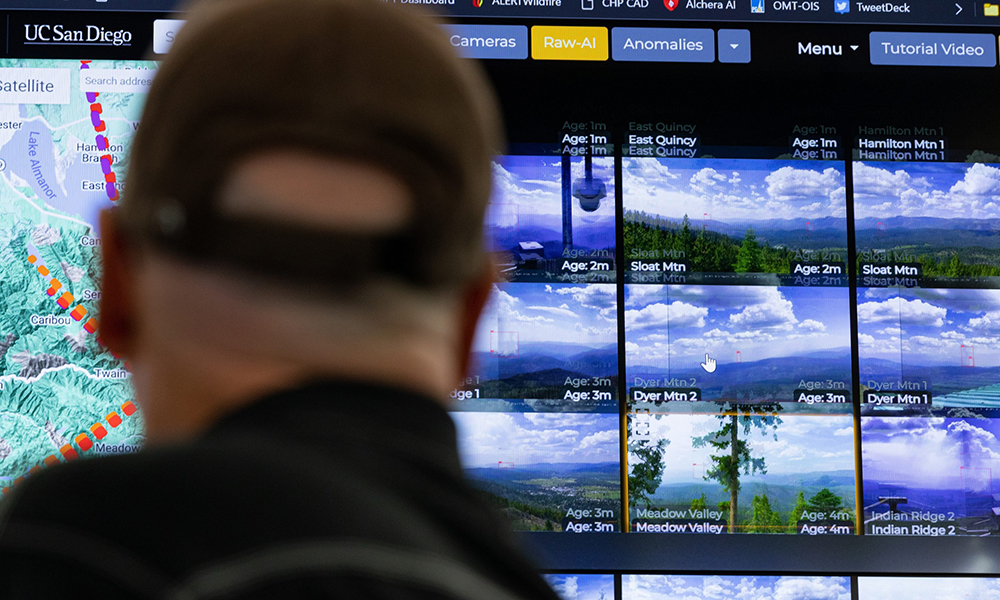
為了實(shí)現(xiàn)《巴黎協(xié)定》的目標(biāo),,到2030年全世界必須大幅減少溫室氣體排放,。但按照當(dāng)前的排放軌跡,未來(lái)八年,,全球排放量將增加10%,。這只會(huì)使世界各地的大范圍干旱、洪水,、極端高溫和其他毀滅性影響進(jìn)一步惡化,。
在這種極具挑戰(zhàn)性的背景下,顯然必須加快各方面的氣候行動(dòng),。其中一個(gè)機(jī)會(huì)就是人工智能(AI),。研究顯示,AI可以推廣目前經(jīng)過(guò)驗(yàn)證的應(yīng)用和技術(shù),,到2030年有望將全球溫室氣體排放量減少5%至10%,,相當(dāng)于歐盟的年度總排放量。第28屆聯(lián)合國(guó)氣候變化大會(huì)(COP28)首次將AI作為應(yīng)對(duì)氣候變化的關(guān)鍵潛在解決方案之一,,《聯(lián)合國(guó)氣候變化框架公約》(United Nations Framework Convention on Climate Change ,,UNFCCC)在會(huì)上宣布發(fā)起AI創(chuàng)新大挑戰(zhàn),用于發(fā)現(xiàn)和支持發(fā)展中國(guó)家執(zhí)行氣候行動(dòng)的AI驅(qū)動(dòng)解決方案,。
扭轉(zhuǎn)排放軌跡,,需要從政府官員,、商界領(lǐng)袖到技術(shù)專家,所有人積極參與,,朝著共同的方向努力,。政策制定者們要扮演關(guān)鍵角色,有三個(gè)關(guān)鍵優(yōu)先領(lǐng)域?qū)⒅С諥I充分發(fā)揮潛力,。
首先,,政策必須支持AI創(chuàng)新,并用于氣候積極應(yīng)用,。為了推動(dòng)AI的發(fā)展和部署,,需要通過(guò)數(shù)據(jù)共享框架、研發(fā)投資,、可負(fù)擔(dān)的技術(shù)獲取途徑和教育倡議等措施,。政府作為最終用戶,將發(fā)揮關(guān)鍵作用,。如果社區(qū),、國(guó)家或行業(yè)沒有明確的氣候行動(dòng)目標(biāo),AI驅(qū)動(dòng)的創(chuàng)新可能會(huì)各自為政,。資源分配將變得效率低下,。確定AI能夠最直接有效地推動(dòng)氣候行動(dòng)的優(yōu)先創(chuàng)新領(lǐng)域,例如利用AI抗洪水農(nóng)業(yè)種植,、氣候變化調(diào)適和加快能源轉(zhuǎn)型等,,能夠釋放更多資源,集思廣益,。
其次,,政策制定者可以優(yōu)先考慮具有高潛力的使用案例,將效率和優(yōu)化要求納入行業(yè)法規(guī),,從而加快實(shí)現(xiàn)AI的氣候影響,。航空、制造,、發(fā)電和建筑等高排放行業(yè)現(xiàn)有的工藝和傳統(tǒng)基礎(chǔ)設(shè)施,,使用AI能夠更快完成優(yōu)化,而不是徹底重建,,因?yàn)橹亟ㄒ馁M(fèi)大量成本和時(shí)間,。長(zhǎng)期轉(zhuǎn)型投資依舊不可或缺,但同時(shí)應(yīng)該鼓勵(lì)更直接的影響,。
第三,,政策制定者可以幫助確保AI發(fā)展所需要的算力,以零碳能源驅(qū)動(dòng),,例如,,通過(guò)使用AI支持的更完善的負(fù)荷管理改善電網(wǎng)等,。
AI對(duì)人類合作應(yīng)對(duì)氣候變化至關(guān)重要。AI已經(jīng)發(fā)揮了推動(dòng)作用,,例如AI正在幫助個(gè)人獲得更好的,、更可行的信息,幫助企業(yè)優(yōu)化運(yùn)營(yíng),,幫助政府和其他組織改善預(yù)測(cè),。
德國(guó)《能源效率法案》(Energy Efficiency Act)規(guī)定,數(shù)據(jù)中心必須購(gòu)買可再生能源,,并強(qiáng)制重復(fù)使用數(shù)據(jù)中心產(chǎn)生的熱能,。
新加坡利用AI預(yù)測(cè)洪水,測(cè)試抗洪水基礎(chǔ)設(shè)施,。里斯本市使用AI統(tǒng)計(jì)現(xiàn)有的太陽(yáng)能面板庫(kù)存,,并評(píng)估擴(kuò)建潛力。AI收集的數(shù)據(jù)被用于預(yù)測(cè)可再生能源供應(yīng),,進(jìn)而指導(dǎo)建筑法規(guī)和激勵(lì)性預(yù)算的制定,。菲律賓鼓勵(lì)使用AI應(yīng)對(duì)氣候變化適應(yīng)領(lǐng)域的挑戰(zhàn)和降低災(zāi)害風(fēng)險(xiǎn)。
全球的政策制定者都致力于推動(dòng)以負(fù)責(zé)任的方式發(fā)展AI,,這一點(diǎn)至關(guān)重要。但他們也必須有利用AI的潛力解決重大挑戰(zhàn)的政策議程,,如氣候變化挑戰(zhàn),。通過(guò)明智的政策決策發(fā)展AI技術(shù),可能是我們目前能采取的最具有影響力的氣候行動(dòng),,而且可以為我們實(shí)現(xiàn)在這個(gè)十年大幅減少排放的目標(biāo)奠定重要的基礎(chǔ),。
本文作者凱特·布蘭特現(xiàn)任谷歌(Google)首席可持續(xù)發(fā)展官。她之前曾任職于白宮,,擔(dān)任美國(guó)首位聯(lián)邦首席可持續(xù)發(fā)展官,、能源部高級(jí)顧問(wèn)和海軍部長(zhǎng)能源顧問(wèn)。
里奇·萊塞爾現(xiàn)任波士頓咨詢集團(tuán)(Boston Consulting Group,,BCG)的全球董事長(zhǎng),。他還擔(dān)任世界經(jīng)濟(jì)論壇(World Economic Forum)首席執(zhí)行官氣候領(lǐng)袖聯(lián)盟(Alliance of CEO Climate Leaders)首席顧問(wèn)。
《財(cái)富》雜志發(fā)表的其他必讀評(píng)論文章:
? 對(duì)2023年美國(guó)經(jīng)濟(jì)衰退的悲觀預(yù)測(cè)失敗,。他們?yōu)槭裁纯春?024年,?
? 研究發(fā)現(xiàn),新冠仍是更嚴(yán)重的威脅,,但流感也不容忽視
? 使用現(xiàn)代爐灶可能改變非洲的經(jīng)濟(jì)發(fā)展格局,,且有助于減少排放,相當(dāng)于全球飛機(jī)和船舶的排放量
? 美國(guó)正在破壞由它自己主導(dǎo)的世界數(shù)字貿(mào)易秩序(財(cái)富中文網(wǎng))
Fortune.com上發(fā)表的評(píng)論文章中表達(dá)的觀點(diǎn),,僅代表作者本人的觀點(diǎn),,不能代表《財(cái)富》雜志的觀點(diǎn)和立場(chǎng),。
翻譯:劉進(jìn)龍
審校:汪皓
為了實(shí)現(xiàn)《巴黎協(xié)定》的目標(biāo),到2030年全世界必須大幅減少溫室氣體排放,。但按照當(dāng)前的排放軌跡,,未來(lái)八年,全球排放量將增加10%,。這只會(huì)使世界各地的大范圍干旱,、洪水、極端高溫和其他毀滅性影響進(jìn)一步惡化,。
在這種極具挑戰(zhàn)性的背景下,,顯然必須加快各方面的氣候行動(dòng)。其中一個(gè)機(jī)會(huì)就是人工智能(AI),。研究顯示,,AI可以推廣目前經(jīng)過(guò)驗(yàn)證的應(yīng)用和技術(shù),到2030年有望將全球溫室氣體排放量減少5%至10%,,相當(dāng)于歐盟的年度總排放量,。第28屆聯(lián)合國(guó)氣候變化大會(huì)(COP28)首次將AI作為應(yīng)對(duì)氣候變化的關(guān)鍵潛在解決方案之一,《聯(lián)合國(guó)氣候變化框架公約》(United Nations Framework Convention on Climate Change ,,UNFCCC)在會(huì)上宣布發(fā)起AI創(chuàng)新大挑戰(zhàn),,用于發(fā)現(xiàn)和支持發(fā)展中國(guó)家執(zhí)行氣候行動(dòng)的AI驅(qū)動(dòng)解決方案。
扭轉(zhuǎn)排放軌跡,,需要從政府官員,、商界領(lǐng)袖到技術(shù)專家,所有人積極參與,,朝著共同的方向努力,。政策制定者們要扮演關(guān)鍵角色,有三個(gè)關(guān)鍵優(yōu)先領(lǐng)域?qū)⒅С諥I充分發(fā)揮潛力,。
首先,,政策必須支持AI創(chuàng)新,并用于氣候積極應(yīng)用,。為了推動(dòng)AI的發(fā)展和部署,,需要通過(guò)數(shù)據(jù)共享框架、研發(fā)投資,、可負(fù)擔(dān)的技術(shù)獲取途徑和教育倡議等措施,。政府作為最終用戶,將發(fā)揮關(guān)鍵作用,。如果社區(qū),、國(guó)家或行業(yè)沒有明確的氣候行動(dòng)目標(biāo),AI驅(qū)動(dòng)的創(chuàng)新可能會(huì)各自為政,。資源分配將變得效率低下,。確定AI能夠最直接有效地推動(dòng)氣候行動(dòng)的優(yōu)先創(chuàng)新領(lǐng)域,,例如利用AI抗洪水農(nóng)業(yè)種植、氣候變化調(diào)適和加快能源轉(zhuǎn)型等,,能夠釋放更多資源,,集思廣益。
其次,,政策制定者可以優(yōu)先考慮具有高潛力的使用案例,,將效率和優(yōu)化要求納入行業(yè)法規(guī),從而加快實(shí)現(xiàn)AI的氣候影響,。航空,、制造、發(fā)電和建筑等高排放行業(yè)現(xiàn)有的工藝和傳統(tǒng)基礎(chǔ)設(shè)施,,使用AI能夠更快完成優(yōu)化,,而不是徹底重建,因?yàn)橹亟ㄒ馁M(fèi)大量成本和時(shí)間,。長(zhǎng)期轉(zhuǎn)型投資依舊不可或缺,,但同時(shí)應(yīng)該鼓勵(lì)更直接的影響。
第三,,政策制定者可以幫助確保AI發(fā)展所需要的算力,,以零碳能源驅(qū)動(dòng),例如,,通過(guò)使用AI支持的更完善的負(fù)荷管理改善電網(wǎng)等,。
AI對(duì)人類合作應(yīng)對(duì)氣候變化至關(guān)重要。AI已經(jīng)發(fā)揮了推動(dòng)作用,,例如AI正在幫助個(gè)人獲得更好的、更可行的信息,,幫助企業(yè)優(yōu)化運(yùn)營(yíng),,幫助政府和其他組織改善預(yù)測(cè)。
德國(guó)《能源效率法案》(Energy Efficiency Act)規(guī)定,,數(shù)據(jù)中心必須購(gòu)買可再生能源,,并強(qiáng)制重復(fù)使用數(shù)據(jù)中心產(chǎn)生的熱能。
新加坡利用AI預(yù)測(cè)洪水,,測(cè)試抗洪水基礎(chǔ)設(shè)施,。里斯本市使用AI統(tǒng)計(jì)現(xiàn)有的太陽(yáng)能面板庫(kù)存,并評(píng)估擴(kuò)建潛力,。AI收集的數(shù)據(jù)被用于預(yù)測(cè)可再生能源供應(yīng),,進(jìn)而指導(dǎo)建筑法規(guī)和激勵(lì)性預(yù)算的制定。菲律賓鼓勵(lì)使用AI應(yīng)對(duì)氣候變化適應(yīng)領(lǐng)域的挑戰(zhàn)和降低災(zāi)害風(fēng)險(xiǎn),。
全球的政策制定者都致力于推動(dòng)以負(fù)責(zé)任的方式發(fā)展AI,,這一點(diǎn)至關(guān)重要,。但他們也必須有利用AI的潛力解決重大挑戰(zhàn)的政策議程,如氣候變化挑戰(zhàn),。通過(guò)明智的政策決策發(fā)展AI技術(shù),,可能是我們目前能采取的最具有影響力的氣候行動(dòng),而且可以為我們實(shí)現(xiàn)在這個(gè)十年大幅減少排放的目標(biāo)奠定重要的基礎(chǔ),。
本文作者凱特·布蘭特現(xiàn)任谷歌(Google)首席可持續(xù)發(fā)展官,。她之前曾任職于白宮,擔(dān)任美國(guó)首位聯(lián)邦首席可持續(xù)發(fā)展官,、能源部高級(jí)顧問(wèn)和海軍部長(zhǎng)能源顧問(wèn),。
里奇·萊塞爾現(xiàn)任波士頓咨詢集團(tuán)(Boston Consulting Group,BCG)的全球董事長(zhǎng),。他還擔(dān)任世界經(jīng)濟(jì)論壇(World Economic Forum)首席執(zhí)行官氣候領(lǐng)袖聯(lián)盟(Alliance of CEO Climate Leaders)首席顧問(wèn),。
《財(cái)富》雜志發(fā)表的其他必讀評(píng)論文章:
? 對(duì)2023年美國(guó)經(jīng)濟(jì)衰退的悲觀預(yù)測(cè)失敗。他們?yōu)槭裁纯春?024年,?
? 研究發(fā)現(xiàn),,新冠仍是更嚴(yán)重的威脅,但流感也不容忽視
? 使用現(xiàn)代爐灶可能改變非洲的經(jīng)濟(jì)發(fā)展格局,,且有助于減少排放,,相當(dāng)于全球飛機(jī)和船舶的排放量
? 美國(guó)正在破壞由它自己主導(dǎo)的世界數(shù)字貿(mào)易秩序(財(cái)富中文網(wǎng))
Fortune.com上發(fā)表的評(píng)論文章中表達(dá)的觀點(diǎn),僅代表作者本人的觀點(diǎn),,不能代表《財(cái)富》雜志的觀點(diǎn)和立場(chǎng),。
翻譯:劉進(jìn)龍
審校:汪皓
The world must dramatically reduce greenhouse gas emissions by 2030 to meet Paris Agreement goals. Yet based on current trajectories, emissions are set to rise by 10% over the next eight years. This will only accelerate widespread droughts, flooding, extreme heat, and other devastating impacts across the globe.
Against this challenging backdrop, it is clear that acceleration is needed across all fronts of climate action. One of those opportunities lies in artificial intelligence (AI). Research shows that by scaling currently proven applications and technology, AI could mitigate 5 to 10% of global greenhouse gas emissions by 2030–the equivalent of the total annual emissions of the European Union. For the first time, AI was highlighted at COP28 as one of the key potential solutions to tackle climate change, with the United Nations Framework Convention on Climate Change (UNFCCC) announcing the AI Innovation Grand Challenge at the conference to identify and support the development of AI-powered solutions for climate action in developing countries.
Reversing the emissions trajectory will take everyone involved–government officials, business leaders, and technologists–all rowing the boat in the same direction. Policymakers have a central role to play, with three critical priority areas that will allow AI to contribute to its full potential.
First, policies must enable AI innovation and adoption for climate-positive applications. Data sharing frameworks, investment in research, affordable technology access, and education initiatives are needed to drive development and deployment. Government has a key role to play as an end-user. In the absence of clear community, national, or sector-specific objectives for climate action, AI-driven innovation could go off in disjointed directions. Resource allocation would be inefficient. Establishing priority innovation domains where AI could most immediately and effectively advance climate action–such as leveraging AI for flood-resilient farming, climate change adaptation, and accelerating the energy transition–can unlock resources and focus minds.
Second, policymakers should accelerate AI’s climate impact by prioritizing high-potential use cases and embedding efficiency and optimization requirements into industrial regulation. Existing processes and legacy infrastructure in high-emission sectors like aviation, manufacturing, electricity production, and construction, could be more immediately optimized with AI, not just with wholesale reconstruction, which could be costly and take too much time. Long-term transformative investments still need to be made, but more immediate impact should be encouraged.
Third, policymakers can help ensure that the computing resources needed for AI advances are powered by carbon-free energy–for example, through improvements to electricity grids like better load management which AI can enable.
AI can be critical in our collective effort to tackle climate change. AI is already driving progress by helping individuals get better and more actionable information, businesses optimize their operations, and governments and other organizations improve prediction and forecasting.
Germany’s Energy Efficiency Act includes specific regulations requiring data centers to purchase renewable energy and mandates the reuse of the heat they generate.
Singapore is using AI to predict floods and test flood-resilient infrastructure. The city of Lisbon is utilizing AI to map its current inventory of solar panels and assess expansion potential. The data collected is then used to develop forecasts for renewable energy supply, which in turn informs building codes and incentive budgets. The Philippines is advocating using AI to tackle climate change adaptation challenges and disaster risk reduction.
Policymakers globally have been focused on promoting the responsible development of AI–which is critical. But they must also pursue a policy agenda to harness AI’s potential to solve big challenges like climate change. Enabling this technology through smart policy decisions may prove one of the most impactful climate actions we can take today–and would provide a vital down payment on goals to significantly reduce emissions during this decade.
Kate Brandt is the chief sustainability officer at Google. She previously served in the White House as the US’s first Federal Chief Sustainability Office, Senior Advisor at the Department of Energy, and Energy Advisor to the Secretary of the Navy.
Rich Lesser is the global chair at Boston Consulting Group (BCG). He also serves as chief advisor to the World Economic Forum Alliance of CEO Climate Leaders.
More must-read commentary published by Fortune:
? Economic pessimists’ bet on a 2023 recession failed. Why are they doubling down in 2024?
? COVID-19 v. Flu: A ‘much more serious threat,’ new study into long-term risks concludes
? Access to modern stoves could be a game-changer for Africa’s economic development–and help cut the equivalent of the carbon dioxide emitted by the world’s planes and ships
? The U.S.-led digital trade world order is under attack–by the U.S.
The opinions expressed in Fortune.com commentary pieces are solely the views of their authors and do not necessarily reflect the opinions and beliefs of Fortune.






